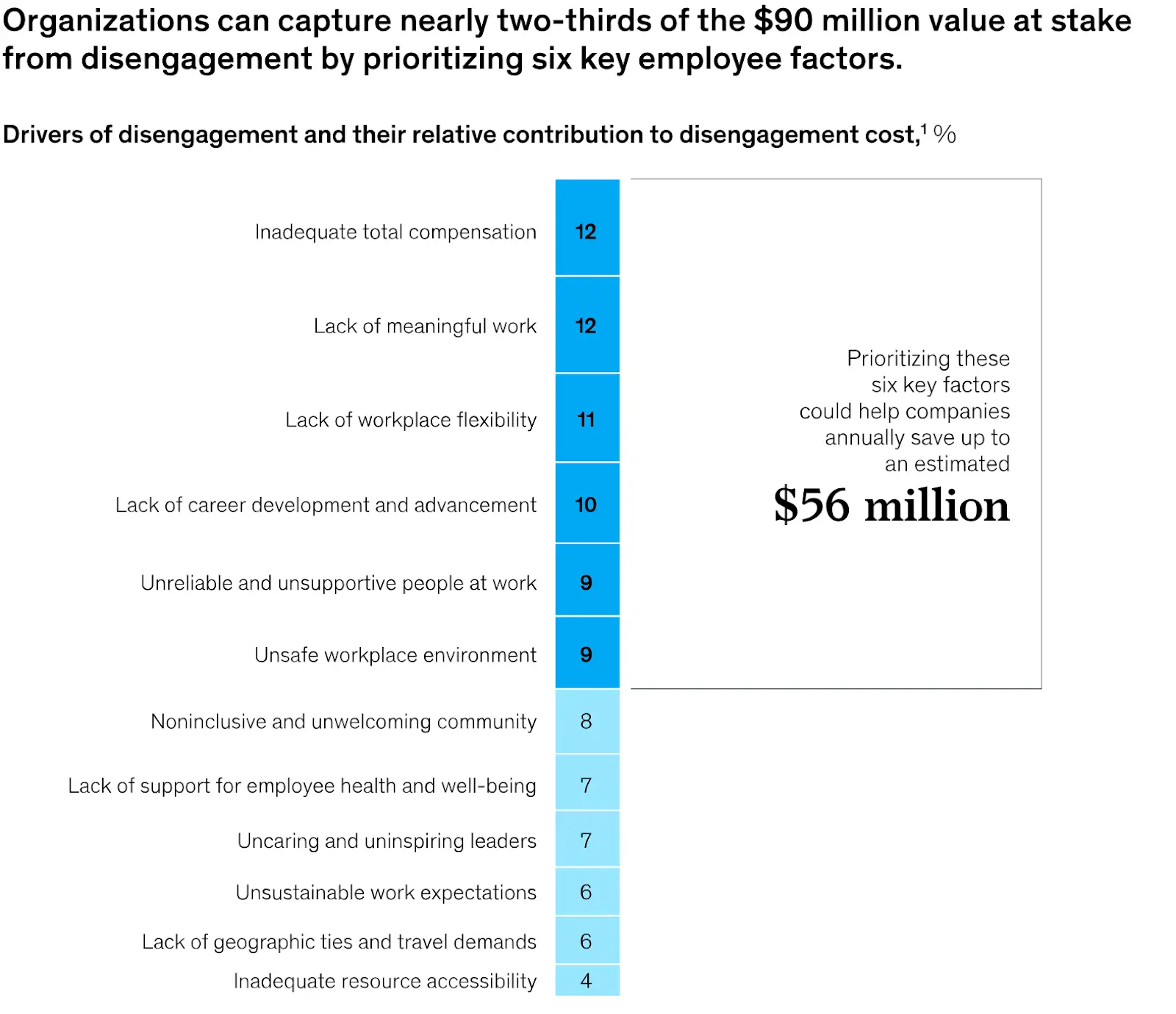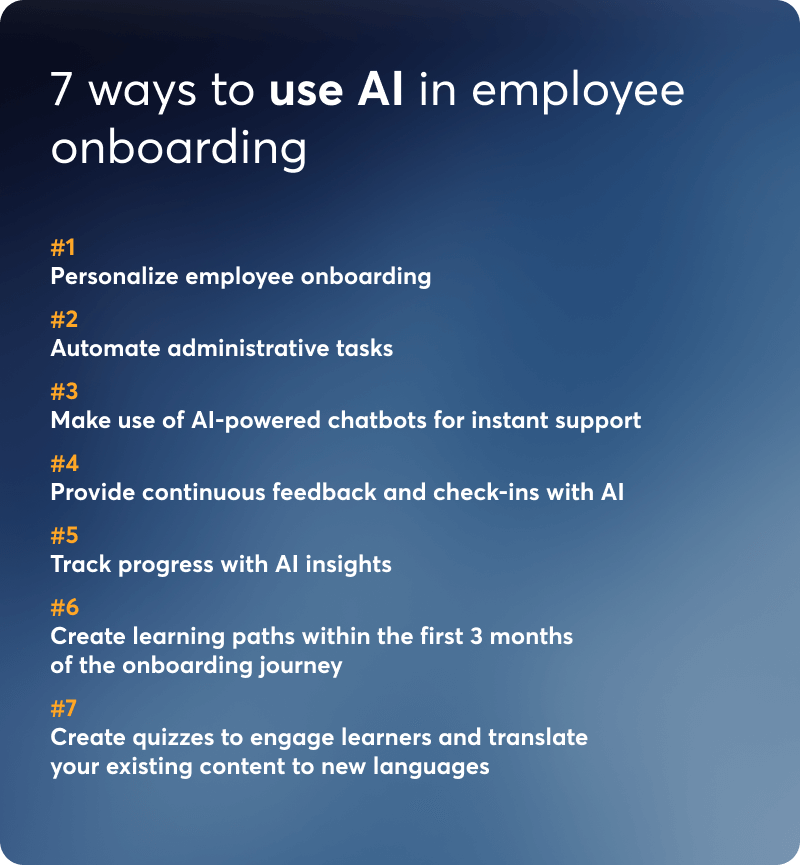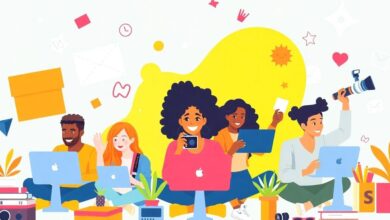How to use AI-powered onboarding to streamline employee onboarding process

Do you onboard new employees but struggle to keep the process engaging and consistent?
What if your onboarding process feels more like a chore, for both your HR team and the new hires?
Or perhaps you wonder how is it possible to onboard remote employees effectively without overloading your team?
You’re not the only one dealing with these issues. Many businesses struggle with high employee turnover, low engagement, and the slow process of traditional onboarding. Studies show that disengaged employees cost companies about $90 million each year in lost productivity [1]. Moreover, a strong onboarding experience engages your new hires, and this has a significant impact.
Engaged employees are more likely to show up consistently and contribute more. According to research, teams with high engagement have an 83% chance to perform above the median and have fewer absences and an up to 14% boost in productivity [2]. Still, when the onboarding process fails to engage and equip new hires, it sets the tone for missed opportunities and reduced retention.
Imagine an onboarding process that works smoothly, saves your HR team a lot of time, and helps every new hire feel welcomed, informed, and ready to start. This can be done with AI-powered onboarding tools designed to automate onboarding effectively.
As Bernard Marr says,
“AI can change onboarding by handling administrative tasks, offering personalized experiences, and helping with better decision-making based on data” [3].
In this article, we will explore how automated onboarding tools can help your organization address onboarding challenges, maximize productivity, and create and create a better experience for new employees.
Whether you are looking to enhance the AI onboarding journey for employees or focus on streamlining onboarding with AI, this guide provides actionable insights to get started.

Key takeaways
AI simplifies employee onboarding by automating administrative tasks and enhancing personalization, ensuring a smoother experience.
AI tools like chatbots and insights provide instant support, track progress, and deliver continuous feedback for effective onboarding.
AI creates engaging learning paths and quizzes, helping new hires quickly adapt and excel within their first three months.
What is employee onboarding?
Employee onboarding is the process of welcoming new hires into an organization and equipping them with the knowledge, skills, and resources they need to succeed. A well-structured onboarding process includes training, socialization, and familiarizing employees with the company culture.
Following such an approach you ensure that new employees feel valued, prepared, and connected. That way you create a seamless onboarding experience that enhances employee satisfaction and engagement.
By solving onboarding challenges and providing continuous support, organizations can keep their employees longer, increase productivity, and improve employee retention, making onboarding a benefit for both the organization and its employees.
What is AI-powered employee onboarding?
I am sure you can imagine a new employee joining your company full of excitement, but after just a few weeks, they feel overwhelmed, disconnected, and unsupported. Does this sound familiar? This happens often, especially for businesses with limited resources or remote workers.
Studies show that effective employee onboarding processes are key for employee retention, but many companies still face problems like inefficiency, inconsistent training, and a lack of personal support [4].
This is where AI-driven onboarding solutions come in to help improve the process. But what exactly is AI-powered employee onboarding? At its core, this approach uses generative artificial intelligence (AI) to create an automated onboarding process for the employee onboarding experience.
Let’s see how the AI enhances the steps of the entire employee onboarding process:
#
Step-by-step onboarding process
Description
1
Offer acceptance
Use AI to personalize offer letters and onboarding kits ensuring the tone and content match the role and individual (e.g., create a tailored welcome email or video featuring details about the company culture and team featuring the CEO’s avatar).
2
Pre-boarding
AI can automate tasks like collecting documents, assigning pre-reading materials, and scheduling team introductions.
3
Orientation
AI streamlines the orientation process by delivering role-specific training sessions, and interactive video tours of the company, including questions or summaries of the critical video points.
4
Role training
Generative AI can also create engaging e-learning content, including ebooks, quizzes, and videos, to make training more interactive and relevant to a new hire’s job description and skills gaps.
5
Competency
AI tracks a new hire’s progress and performance in real time, helping HR professionals identify skill gaps and areas for improvement.
6
End of probation
AI tools can analyze employee performance metrics to ensure a smooth transition beyond the probationary period.
7
First-year review
Generative AI can automate recognition efforts, such as personalized anniversary messages, videos, or certificates of achievement. AI insights from the first-year review can guide further development strategies.
8
Personal progress
AI can encourage self-directed learning by recommending courses, certifications, and upskilling opportunities based on an employee’s interests and career trajectory, fostering a culture of continuous improvement.
Step-by-step onboarding process
Description
Offer acceptance
Use AI to personalize offer letters and onboarding kits ensuring the tone and content match the role and individual (e.g., create a tailored welcome email or video featuring details about the company culture and team featuring the CEO’s avatar).
Pre-boarding
AI can automate tasks like collecting documents, assigning pre-reading materials, and scheduling team introductions.
Orientation
AI streamlines the orientation process by delivering role-specific training sessions, and interactive video tours of the company, including questions or summaries of the critical video points.
Role training
Generative AI can also create engaging e-learning content, including ebooks, quizzes, and videos, to make training more interactive and relevant to a new hire’s job description and skills gaps.
Competency
AI tracks a new hire’s progress and performance in real time, helping HR professionals identify skill gaps and areas for improvement.
End of probation
AI tools can analyze employee performance metrics to ensure a smooth transition beyond the probationary period.
First-year review
Generative AI can automate recognition efforts, such as personalized anniversary messages, videos, or certificates of achievement. AI insights from the first-year review can guide further development strategies.
Personal progress
AI can encourage self-directed learning by recommending courses, certifications, and upskilling opportunities based on an employee’s interests and career trajectory, fostering a culture of continuous improvement.
From streamlining employee onboarding with AI to creating personalized learning paths, companies are turning to AI-driven onboarding solutions to:
Reduce time spent on repetitive tasks like document collection and policy dissemination.
Provide tailored experiences that ensure new hires feel valued and supported.
Perform real-time performance data analysis, giving HR professionals actionable insights to improve retention and engagement.
Do you realize how simple the solution is? Using AI-supported onboarding solutions can make the whole process smoother and more engaging. In the next part, we will look at the main benefits of these tools and how they solve the biggest problems faced by HR teams, training departments, and business leaders.
Benefits of AI in employee onboarding
We will now discuss the potential that AI-driven onboarding processes offer, like limiting repetitive administrative tasks, personalizing onboarding processes, and saving costs. We hope that after reading this article you will realize that AI-driven onboarding solutions can redefine employee onboarding and employee training process.
Streamlined administrative tasks
What if onboarding paperwork could handle itself? Instead of spending hours verifying employment details, collecting personal documents, and entering data manually, your team could focus on what matters—welcoming and supporting new hires.
This isn’t wishful thinking. AI-enabled employee onboarding automates onboarding manual processes by managing employment verification, document collection, and data entry. These systems ensure that everything happens seamlessly and accurately, reducing errors and saving valuable time for HR staff.
Streamlining employee onboarding processes with AI allows you to create a more human, impactful experience—while the tech takes care of the rest.
Enhanced personalization
Do you remember your very first day at work? Were you made to feel special or just another face in the crowd?
For many employees, onboarding feels generic and uninspired. But it doesn’t have to be this way. Personalized AI onboarding plays a crucial role in the AI journey for employees by ensuring that every new hire feels valued and supported by tailoring their experience to their unique needs.
AI onboarding tools analyze skills, the new hires’ profiles and career goals to create customized training paths. For example, a technical employee might receive hands-on modules, while a new manager might be guided toward leadership programs. AI can even deliver employee multilingual onboarding materials to support diverse teams.
Consider all the above and you show your employees that they matter while boosting their engagement, confidence, and satisfaction.
Cost-effectiveness
Employee onboarding doesn’t have to cost more as your team grows either. Does this come as a surprise? Unlike traditional methods that demand more resources as hiring scales, AI-driven employee onboarding processes handle growth without additional costs. Here’s how:
Scalability: Whether onboarding 10 or 100 employees, AI-driven onboarding solutions perform at the same cost, freeing HR professionals from scaling headaches.
Faster productivity: AI helps new employees get up to speed quickly with clear onboarding steps and easy access to training that fits their needs, saving time and keeping things running smoothly.
Error-free processes: Mistakes in compliance or payroll? AI ensures accuracy, saving businesses from penalties and delays.
Having read about the key benefits of AI in employee onboarding, here is my question to you. How could AI-supported onboarding transform your organization? Please take a moment to think about it. The potentials are clear to me, but if you don’t feel ready yet to answer this question, you better keep reading.
In the next part, we will turn to practical strategies and explain how you can use AI in employee onboarding to improve its impact on your business.
How to use AI in employee onboarding
Let’s dive into the practical side of things. You have read about the benefits of an AI-powered onboarding process, but how do you actually apply these tools in your organization?
Regardless of whether your goal is to simplify repetitive tasks, create personalized AI onboarding journeys, or enhance the experience for new employees, this section offers actionable ideas to ensure a successful onboarding process.

Personalized onboarding experiences
Personalization is at the heart of a great onboarding experience. With the right AI onboarding tools, you can tailor the onboarding process for each employee by analyzing their skills, career goals, and role-specific needs. For example:
Skills matching: AI systems can identify the specific skills linked to a role and recommend training materials or resources to help build those skills. For example, a new hire in the engineering team might receive technical coding challenges, while someone in sales gets roleplays for client conversations.
Customized content creation: Generative AI can adapt learning materials to suit different departments. This ensures that new team members in engineering get highly technical resources, while those in sales could receive materials linked to soft skills for practical training.
This level of personalization solves common challenges faced by HR departments, such as onboarding newly hired employees with varying levels of experience.
Automating administrative tasks
The most time-consuming part of onboarding is often the paperwork. This is where automated onboarding processes shine, transforming the way HR staff manage administrative tasks.
AI can handle:
Pre-onboarding tasks: From sending offer letters and contracts to verifying employment eligibility, AI ensures these steps are completed faster and without manual errors.
Account setups: AI can automatically create email addresses, set up HR system access, and assign logins for software tools—all before the employee’s first day.
Workspace preparation: Need to order laptops or assign desks? AI tools integrate with IT and facilities systems to streamline these processes.
AI saves HR professionals hours of work per hire and reduces delays caused by human error, especially by automating administrative tasks.
This means new hires walk into a fully prepared environment where they can start contributing immediately, fostering a smooth transition into their roles. At the same time, HR teams can focus on creating an experience that makes employees feel welcomed rather than getting bogged down in administrative details.
AI-powered chatbots for instant support
AI-powered chatbots are like having a personal onboarding buddy available 24/7. For new hires, the onboarding process can feel overwhelming, especially when they are navigating new systems, policies, or tools.
Chatbots can simplify this experience by providing instant answers, guiding employees through the onboarding steps, and managing routine tasks.
Here’s how they help:
Answering questions in real-time: It could be a login issue or a query on benefits enrollment, but chatbots ensure no question goes unanswered, helping employees feel supported and confident.
Document management: Chatbots can request, collect, and verify essential documents like IDs or tax forms, ensuring compliance without delays.
Policy acknowledgments: The same tools can share company policies and track acknowledgment receipts, removing the need for manual follow-ups.
Scheduling made easy: Need to schedule training or orientation? Chatbots handle it too, sending reminders to keep new employees on track.
According to IBM [5], IBM’s Watson Assistant reduced the time employees spent on common HR tasks by 75%. With AI handling these repetitive onboarding tasks, HR staff can invest their time on creating a more meaningful onboarding experience for the new team members.
Continuous feedback and check-ins with AI
Feedback is an important part of a good onboarding process, and AI makes it effortless. AI tools gather feedback from new employees, helping them get the support they need to succeed.
Here’s how it works:
Feedback surveys: These tools collect data from surveys sent at important times, like after training or the first month, to gather input.
Response analysis: AI analyzes survey responses to measure how employees feel and identify any potential issues early on.
Assignment feedback: For roles where training with assignments is essential, like customer success or sales, AI can evaluate onboarding assignments (e.g., how a sales representative handles mock calls) and provide tailored feedback to enhance their performance.
AI helps HR professionals gather and analyze feedback, ensuring the transition of employees progresses smoothly and the onboarding process continues to evolve.
Tracking progress with AI insights
AI insights help HR teams to see both the overall trends and the finer details of their employee’s onboarding.
First, AI provides a live view of where each employee stands in their onboarding process, from completed training modules, progress, quiz scores, and certifications earned to areas still pending.
Second, AI identifies which skills a new hire is excelling in and where they may need extra support according to their performance in their training materials.
Third, such tools allow comparisons of employees’ performance highlighting who might need some extra mentoring or additional training.
With AI insights, HR professionals can ensure every employee’s unique needs are met promptly, leading to better employee engagement and higher retention rates. This is extremely important to remember and that’s why I need to mention once again what a Gallup survey revealed [2]:
Companies with engaged employees experience see higher chances of having lower absences and improvement in profits compared to companies with low employee engagement rates.
Create learning paths within the first three months
The first three months of onboarding are critical for setting up new hires for success. According to the 14th annual Job Seeker Nation Report [6], 24% of employees leave their jobs within the first 90 days of starting a new role. For HR teams and hiring managers, this shows how crucial it is to have a clear and engaging onboarding process to stop employees from leaving too soon.
AI tools create personalized and structured training plans for each new employee, giving them the skills and knowledge they need to do well.
For example, in a retail company, AI might create a training path for a sales associate that prioritizes product knowledge, customer communication, and checkout processes. For an IT specialist, it would focus on troubleshooting workflows and internal system navigation.
Structured programs created with AI ensure that each new team member gets the support they need, resulting in higher employee satisfaction, engagement, confidence, and seamless integration into their role.
Create quizzes to engage learners and translate your existing content to new languages
AI has made creating quizzes and translating onboarding materials easier than ever. Engaging new employees in the onboarding process is vital, and quizzes can help reinforce key concepts while making learning interactive.
Generative AI tools embedded in an LMS allow HR professionals to quickly create:
Quizzes with multiple types of questions to test knowledge retention.
Scenario-based assessments for roles like customer support or management.
Therefore, testing understanding but also keeping employees engaged throughout the onboarding process becomes even easier.
Apart from quizzes, translating content is also critical. So, if you are engaged in global onboarding processes, fear not. AI makes it easy and simple for companies to translate training materials for international employees:
AI tools can translate entire ebooks, training manuals, or presentations into multiple languages with just a few clicks.
For videos or audio, AI can generate subtitles or transcripts in any language, ensuring that your onboarding experience is inclusive for all new hires.
With AI simplifying quizzes and translations, HR teams can build a more accessible onboarding process for remote onboarding and international hires, ensuring new hires feel welcomed and supported at all times.
Final thoughts
In the AI journey for employees, onboarding begins with addressing the challenges that HR professionals and hiring managers face daily: managing onboarding tasks, engaging new employees, and improving employee retention.
Throughout this article, we have highlighted how AI-driven onboarding tools simplify processes, create tailored learning paths, and track progress to ensure every new hire’s onboarding experience is engaging and productive.
But achieving all of this in one place might feel like a daunting task. LearnWorlds is the all-in-one LMS that can support you in transforming the entire employee onboarding process into an efficient, personalized, and measurable automated employee onboarding journey.
Our platform offers several features that allow HR professionals and L&D teams in particular to deliver personalized employee training experiences:
Tailored navigation paths: Creating website pages with different after-login pages, custom sign-up fields, and different visibility options that can guide new employees at each stage of their onboarding and can be tailored to each employee’s role and needs.
Custom learning paths: Designing programs aligned with specific objectives, ensuring that new hires gain role-relevant skills.
Curated learning content: Deliver content personalized for each learner’s needs to optimize their success.
Segmented communication: Use tools like qualification forms, user tagging, and group segmentation to deliver the right message to the right learners.
LearnWorlds goes even further with its AI tools, offering advanced capabilities like:
AI insights: Track real-time progress, identify skill gaps, and compare performance across new hires.
AI-powered Course Planner: Generate course outlines tailored to specific roles or objectives.
Assessment Designer: Turn existing content into quizzes or exams to evaluate and reinforce learning.
Content creator tools: Easily create ebooks, emails, and interactive videos and translate materials with AI-enhanced precision, ensuring consistency and clarity.
AI Content Editor: Effortlessly enhance the quality and consistency of your pages, ebooks, emails, and course materials. Whether refining messages or repackaging content, this tool ensures every piece aligns with your organization’s goals.
Feedback generator: Provide detailed, consistent feedback to new employees, ensuring clarity and precision across instructors.
These tools automate repetitive tasks while simultaneously enhancing employee engagement. Moreover, they empower HR teams to create a seamless onboarding experience that supports organizational goals.
Have you considered how much smoother your onboarding process could be with an all-in-one platform like LearnWorlds? What could a more engaging, efficient, and scalable onboarding journey mean for your team and your company’s future?
The next step is yours to take. Explore how LearnWorlds can reimagine the way you onboard and train employees, enhance employee satisfaction, and set your organization up for long-term success. Start building a personalized, AI-enhanced onboarding experience today with LearnWorlds’ free trial and see the difference it makes for your business.
FAQs
What is the AI onboarding process?
AI onboarding is the onboarding process that uses artificial intelligence to enhance and streamline the way new employees are welcomed into a company. It handles automating repetitive tasks like document collection training session scheduling and more, making onboarding more efficient and engaging.
What is AI-powered recruitment?
AI-powered recruitment is the recruitment process that leverages AI onboarding tools to optimize and automate parts of the hiring process, such as screening resumes, scheduling interviews, and assessing candidate fit through predictive analytics.
How to onboard your team to work with AI?
Here are the steps on how to onboard your team to work with AI:
Communicate the vision: Explain the benefits of AI and how it supports your goals.
Educate and train: Provide workshops or courses tailored to your team’s roles.
Start small: Begin with pilot projects to show value and build confidence.
Choose tools wisely: Use user-friendly AI tools with clear documentation and support.
Promote collaboration: Encourage teamwork between technical and non-technical members.
Address concerns: Emphasize ethical practices and how AI complements human roles.
Celebrate wins and iterate: Highlight successes and improve based on feedback.
How can AI create personalized onboarding experiences?
AI personalizes the onboarding journey by analyzing employee data—such as skills, roles, and goals—and curating tailored learning paths, training content, and even communication. Platforms like LearnWorlds enhance this personalization through features like custom navigation paths, segmented communication, and curated resources.
Sources
[1] https://www.mckinsey.com/capabilities/people-and-organizational-performance/our-insights/some-employees-are-destroying-value-others-are-building-it-do-you-know-the-difference [2] https://www.gallup.com/workplace/321725/gallup-q12-meta-analysis-report.aspx [3] https://www.linkedin.com/pulse/ai-enhanced-employee-onboarding-new-era-hr-practices-bernard-marr-gcwae/ [4] Ritz, E., Donisi, F., Elshan, E., & Rietsche, R. (2023). Artificial Socialization? How Artificial Intelligence Applications Can Shape A New Era of Employee Onboarding Practices. In Proceedings of the 56th Hawaii International Conference on System Sciences (pp. 155-164). Maui, Hawaii, USA. [5] https://www.ibm.com/think/topics/chatbots-for-hr [6] https://www.jobvite.com/lp/employ-job-seeker-nation-report-2024/#report(Visited 2 times, 2 visits today)
Panagiota is an Instructional Technologies Specialist at LearnWorlds, holding a Ph.D. in Technology Enhanced Learning. Her research focuses on the integration of educational technologies into learning and instruction. In her spare time, she enjoys gardening and staying connected with nature.




